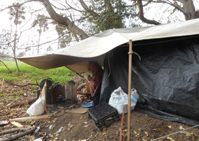
Homeless Census 2015
Philip Boo Riley
Every two years cities across the country complete a HUD-mandated census of homeless people. In 2013 San Jose/Silicon Valley’s homeless numbers ranked fifth nationally among major urban areas. I’ve volunteered for the last three censuses, showing up with my car and cell phone at my embarkation point around 5:30 a.m. to pick up a map with the census tract to cover and meet the one or two homeless people who serve as guides for volunteers like me. We’d spend the next 4-5 hours driving and walking around, tallying (they call it “point in time”) the number of homeless individuals, families, children, and encampments we see in our tract. A plus to this volunteer work is that I spend time with people I usually do not meet—my homeless guide for 2015 had just been released from over twenty years in prison, and until finding a place at the San Jose Family Shelter, he and his wife and her 14 year old daughter had been living in their car.
Although a practice not encouraged by the people running the census, my guide wanted to help me make contact with other homeless people, so we had several conversations with the people we were counting—including the gentleman in this photo, who I learned had emigrated from Viet Nam over twenty years ago. He has been living on the banks of Coyote Creek near the San Jose Golf Course for the past 18 months. The census culminates in 100+ page reports published later in the year. It is interesting to read through the data charts and policy recommendations and realize that they began with volunteers and guides trying to make contact with people who are finding their way in the Silicon Valley without a home.